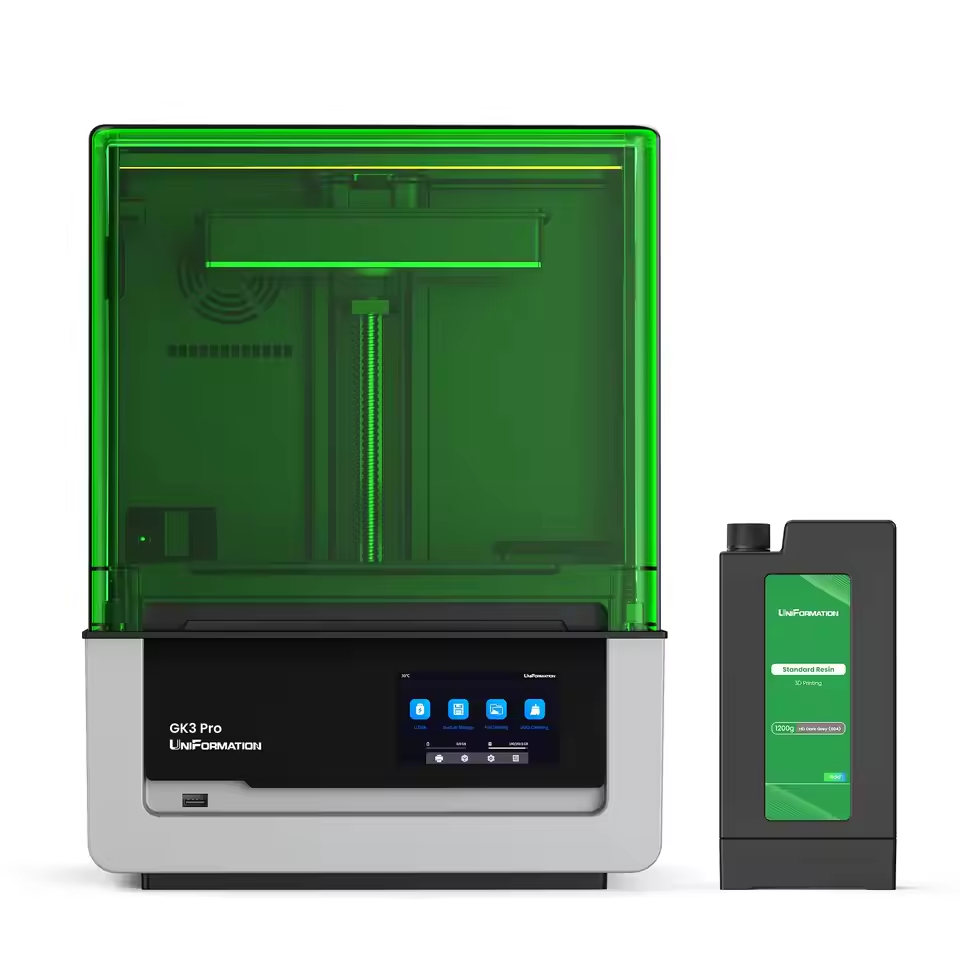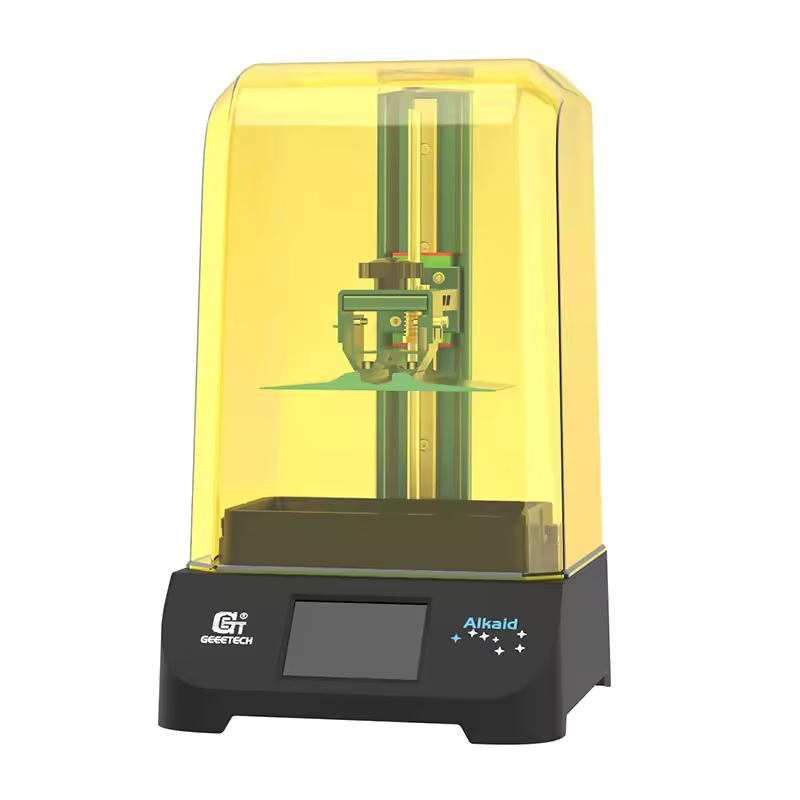What is a Resin Printer?
A resin printer is a type of 3D printer. It uses liquid resin to create objects layer by layer. Resin printers are known for their ability to produce highly detailed and smooth surface finishes. They are perfect for creating intricate designs, prototypes, and small-scale models. Unlike other 3D printers, resin printers rely on light to harden the resin material.

How Does a Resin Printer Work?
A resin printer works through a process called photopolymerization. It involves curing liquid resin with a light source. Here’s a simple explanation:
- Tank of Resin: The printer has a reservoir filled with liquid resin.
- Light Source: It uses UV light to solidify specific sections of the resin.
- Layer Building: The hardened layers stack up to form the final 3D object.
- Lift Process: As layers cure, the build plate lifts the object out of the resin.
Differences Between Resin and Filament 3D Printers
Resin and filament 3D printers serve different needs. Here are the main differences:
- Material: Resin printers use liquid resin, while filament printers use plastic filaments.
- Detail and Precision: Resin printers produce finer, smoother details than filament ones.
- Strength: Filament prints are often more durable but less detailed.
- Speed: Filament printers generally work faster but lose detail quality.
- Cost: Resin printers can be pricier due to resin and maintenance costs.
Resin printers excel in intricate designs, while filament printers handle larger, simpler projects better.
Types of Resin Printers
Resin printers come in three main types. They differ in technology and areas of strength. Understanding these types helps to choose the right printer for specific needs.
SLA (Stereolithography) Printers
SLA printers are the pioneers of resin printing technology. They rely on lasers to cure liquid resin.
- How They Work: A focused laser traces each layer of an object in the resin tank. The laser solidifies the resin layer by layer until the object is complete.
- Advantages: SLA printers provide exceptional precision and smooth finishes. They are great for detailed designs, jewelry, and prototypes.
- Ideal Users: Professionals and hobbyists who need highly detailed and smooth creations.
DLP (Digital Light Processing) Printers
DLP printers use a digital projector screen to cure resin all at once.
- How They Work: A projector displays an image of the layer to solidify, curing the entire layer at once.
- Speed and Detail: They are faster than SLA printers but maintain high details. However, pixelation may appear on highly detailed work.
- Advantages: Ideal for those who need good detail and faster printing speed.
- Best Uses: Applications include dental molds, engineering prototypes, and medium-detail models.
LCD/MSLA Printers
LCD, also called MSLA (Masked Stereolithography), is the newest resin printer type. They use an LCD screen with UV light to cure resin.
- How They Work: The LCD masks the light to create patterns, curing the resin layer by layer.
- Cost and Resolution: LCD printers are more affordable and offer high resolution. Resolution depends on the LCD screen’s quality.
- Advantages: These printers are cost-effective with precise results. They are ideal for beginners and hobbyists.
Choosing the right resin printer type depends on specific needs. Each type offers unique benefits for different projects and skill levels.
Choosing the Right Resin Printer
Finding the right resin printer can be challenging. Consider your needs and budget before deciding.
Factors to Consider Before Purchase
When selecting a resin printer, focus on key factors to get the best value and performance:
- Printing Speed: Faster printers save time on larger or frequent projects. SLA printers may be slower but offer precision, while DLP and LCD/MSLA types are quicker for most tasks.
- Resolution and Details: High-resolution printers offer finer details. Look for models with superior screen or laser quality.
- Budget: Resin printers vary in cost. LCD/MSLA printers are affordable for beginners, while SLA/DLP options suit professionals.
- Build Volume: A larger build volume accommodates bigger projects. Smaller volumes suit detailed works like jewelry.
- Ease of Use: Choose printers with intuitive setup and operation, especially as a beginner.
- Resin Costs: Factor in the cost of resin materials. Premium brands may have higher expenses.
- Support and Warranty: Reliable customer service and warranty coverage ensure peace of mind after purchase.
Popular Resin Printer Brands and Models
Several brands offer exceptional performance and application versatility:
- Anycubic: Known for affordable models like Photon Mono. Ideal for hobbyists and small-scale work.
- Elegoo: Offers budget-friendly printers like Mars 3, perfect for beginners seeking detailed prints.
- Formlabs: Provides premium options such as Form 3+. These printers excel in professional-grade work.
- Phrozen: Specializes in high-resolution printers like Sonic Mini 4K. Suitable for detailed engineering and prototypes.
- Creality: Offers versatile models like LD-002R. It bridges affordability and excellent printing quality.
Each brand caters to specific needs and budgets. Research thoroughly before purchasing the best resin printer for your projects.
Setting Up Your Resin Printer
Setting up your resin printer correctly ensures smooth operation and quality prints. Follow these steps to prepare for success.
Initial Setup and Preparation
- Find a Proper Workspace
- Choose a well-ventilated and clean area for your printer. Avoid direct sunlight.
- Ensure you have a sturdy, level surface to prevent vibrations during printing.
- Unbox and Inspect
- Carefully unpack your printer and accessories. Check for any shipping damage or missing parts.
- Read the manual. Understanding your printer’s parts and functions is crucial.
- Install the Printer Components
- Attach the build plate and resin tank securely. Ensure alignment and stability.
- Check if the build plate requires leveling. This step varies by printer model.
- Load Resin
- Shake the resin bottle thoroughly. This ensures all components mix well.
- Pour the resin into the tank up to the maximum fill line. Avoid overfilling.
- Power On and Test
- Connect your printer to a power source and turn it on.
- Run a test print to confirm everything is working correctly.
- Install Software or Firmware Updates
- Download and install slicing software from the manufacturer’s website.
- Check for firmware updates to improve functionality and compatibility.
Essential Tools and Accessories
- Personal Protective Equipment (PPE)
- Use nitrile gloves and safety goggles to protect against resin exposure.
- Wear a respirator if working in areas with limited ventilation.
- Slicing Software
- Choose software that converts 3D models into printable layers. Ensure compatibility with your printer.
- Cleaning Supplies
- Keep paper towels, isopropyl alcohol, and a cleaning container on hand.
- These are essential for cleaning prints and your printer.
- Scraper Tools
- Use plastic or metal scrapers to remove cured parts from the build plate.
- Avoid scratches or damage to the plate.
- Post-Processing Essentials
- Consider a UV curing station or sunlight for final curing.
- Brushes and tweezers are helpful for removing supports and cleaning details.
By preparing adequately and using proper tools, you’ll set a strong foundation for successful printing.
Using Resin Printers Safely
Resin printers are powerful tools, but they require careful attention for safe use. Focusing on proper handling and a clean workspace will protect you and your projects.
Safety Tips for Handling Resin
- Wear Protective Gear: Always wear nitrile gloves and safety goggles to avoid resin contact with skin and eyes.
- Avoid Direct Skin Contact: Resin can cause irritation or allergic reactions. Use tools to handle resin when needed.
- Keep Resin Bottles Sealed: Store resin properly to prevent spills and exposure to air, which can degrade the material.
- Dispose of Resin Waste Properly: Dispose of resin waste according to local guidelines. Avoid pouring it directly into drains.
- Wash Hands After Use: Always clean your hands thoroughly after handling resin and resin-related items.
Proper Ventilation and Cleanup Practices
- Work in a Ventilated Area: Use a well-ventilated workspace to prevent inhaling resin fumes, which can be harmful.
- Install Air Filters or Fans: Air filters reduce fumes; fans improve air circulation in enclosed spaces.
- Clean Spills Immediately: Use paper towels and isopropyl alcohol to clean resin spills. Prevent dried resin buildup.
- Use Dedicated Cleaning Containers: Have specific containers for washing resin-printed items to reduce contamination.
- Dispose Cleaning Materials Safely: Dispose of used gloves, towels, and alcohol safely to avoid environmental damage.
Following these steps will ensure safe and efficient operation of your resin printer and protect your health.
Maintenance and Troubleshooting
Maintaining your resin printer ensures consistent performance and extends its lifespan. Proper troubleshooting saves time and avoids frustration.
Cleaning and Caring for Your Printer
- Regular Cleaning: Clean the build plate and resin tank after each print. Avoid resin buildup.
- Wash Resin Tank: Use isopropyl alcohol and a soft cloth to clean the tank gently.
- Inspect and Replace: Check printer components routinely. Replace worn-out parts, such as FEP film.
- Monitor the Screen: Clean the LCD screen regularly. Avoid scratches that affect print accuracy.
- Lubricate Moving Parts: Apply lubricant to ensure smooth motion of axes and build plate.
- Free Air Vents: Clear vent openings to prevent overheating and maintain airflow.
Addressing Common Printing Issues
- Failed Prints: Check print settings and ensure the build plate is level. Verify resin exposure time.
- Layer Separation: Inspect FEP film for damage and adjust peeling force settings.
- Overexposure Lines: Lower UV power settings or reduce exposure time to fix excessive curing.
- Stuck Prints: Use a scraper carefully to remove stuck items. Adjust layers if needed.
- Printer Errors: Check software and firmware versions for compatibility. Update them when necessary.
- Printing Artifacts: Redesign models to eliminate unsupported features. Ensure proper STL file integrity.
By following maintenance steps and troubleshooting errors, your resin printer will deliver optimal results consistently.
Creative Applications of Resin Printers
Resin printers are versatile tools that can produce highly detailed and functional creations. Their precision makes them suitable for various creative and industrial applications. From intricate models to advanced prototypes, resin printing opens up new possibilities for many fields.
Models, Prototypes, and Artistic Creations
- Detailed Models: Resin printers are perfect for crafting highly detailed miniature models. Hobbyists use them for figurines, dioramas, and tabletop gaming pieces. The smooth surface and sharp details enhance the visual appeal of these creations.
- Functional Prototypes: Designers and engineers can create accurate prototypes for testing and iteration. Resin printing helps identify flaws in a design before mass production.
- Jewelry Making: Precise detailing and smooth finishes make resin printers ideal for custom jewelry production. Designs can include fine textures and complex shapes that traditional methods cannot achieve.
- Artistic Sculptures: Artists can bring their sculptures and abstract designs to life using resin prints. The printers accommodate intricate shapes and fine details, supporting artistic creativity.
- Custom Accessories: Resin printers allow personalized creations, such as custom phone cases and decorations. These items can be tailored to user preferences with ease.
Industries Benefiting from Resin Printing
- Dental Sector: Resin printers produce dental molds and aligners with precision. Their accuracy helps create custom-fit items efficiently.
- Medical Applications: They are used for surgical guides, prosthetics, and anatomical models. Detailed prints help in pre-surgical planning and research.
- Engineering and Prototyping: Engineers use resin printers for prototypes and functional parts testing. This saves time and cost in product development.
- Architecture: Architects print intricate building models and miniature designs using resin printers. High details aid in presentation and planning.
- Education Sector: Schools and institutes use resin printers to teach design concepts and showcase 3D projects effectively.
- Fashion and Design: Resin printers enable creative designs in fashion accessories and innovative wearable items.
By leveraging resin printing capabilities, creators and industries push the boundaries of traditional manufacturing and art.
